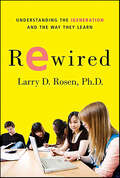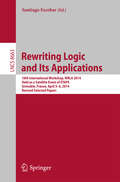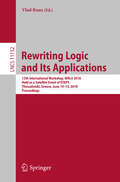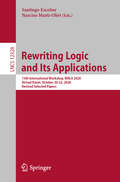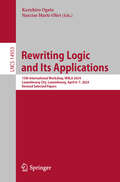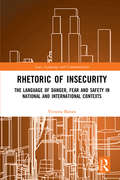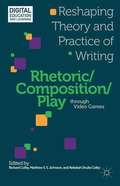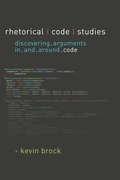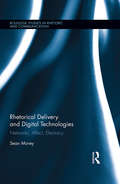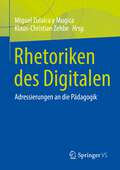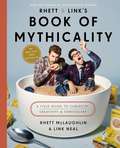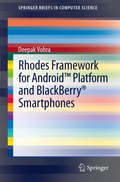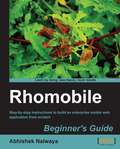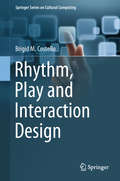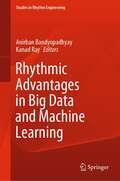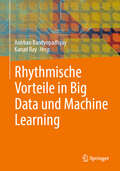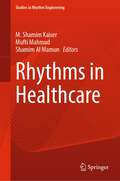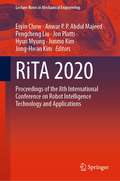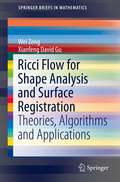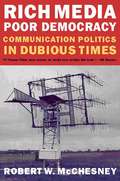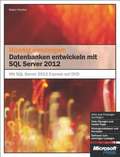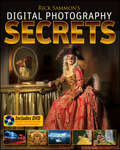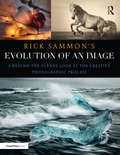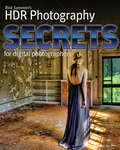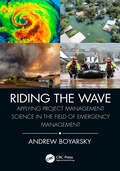- Table View
- List View
Rewired: Understanding the iGeneration and the Way They Learn
by Larry Rosen“This book offers insight and help to motivate and maximize learning for the Internet Generation”—from the coauthor of The Distracted Mind (Eric Milou, Professor of Mathematics, Rowan University).Look around at today's youth and you can see how technology has changed their lives. They lie on their beds and study while texting and chatting online with friends and scrolling through TikTok. How does the new, charged-up, multitasking generation respond to traditional textbooks and lectures? Are we effectively reaching today's technologically advanced youth? Rewired is the first book to help educators and parents teach to this new generation's radically different learning styles and needs. This book will also help parents learn what to expect from their “techie” children concerning school, homework, and even socialization. In short, it is a book that exposes the impact of generational differences on learning while providing strategies for engaging students at school and at home.“Larry's research-based, positive, proactive messages are a welcome relief from the unsupported fear-based messages that are unfortunately also present. Rewired should be considered a ‘must-read' by all professionals who work with youth, especially those in leadership positions.” ―Nancy Willard Director of Center for Safe and Responsible Internet Use
Rewriting Logic and Its Applications
by Santiago EscobarThis book constitutes the thoroughly refereed post-workshop proceedings of the 10th International Workshop on Rewriting Logic and its Applications, WRLA 2014, held as a satellite event of ETAPS 2014, in Grenoble, France, in March 2014. The 13 revised full papers presented together with 3 invited papers were carefully reviewed and selected from 21 submissions. The papers address a great diversity of topics in the fields of foundations and models of RL; languages based on RL; RL as a logical framework; RL as a semantic framework; use of RL to provide rigorous support for model-based software engineering; formalisms related to RL; verification techniques for RL specifications; comparisons of RL with existing formalisms having analogous aims; application of RL to specification and analysis of distributed systems and physical systems.
Rewriting Logic and Its Applications: 12th International Workshop, Wrla 2018, Held As A Satellite Event Of Etaps, Thessaloniki, Greece, June 14-15, 2018, Proceedings (Lecture Notes in Computer Science #11152)
by Vlad RusuThis book constitutes revised selected papers from the 12th International Workshop on Rewriting Logic and Its Applications, WRLA 2018, held in Thessaloniki, Greece, in June 2018. The 12 full papers presented in this volume were carefully reviewed and selected from 21 submissions. They deal with rewriting, a natural model of computation and an expressive semantic framework for concurrency, parallelism, communication, and interaction, and its applications.
Rewriting Logic and Its Applications: 13th International Workshop, WRLA 2020, Virtual Event, October 20-22, 2020, Revised Selected Papers (Lecture Notes in Computer Science #12328)
by Santiago Escobar Narciso Martí-OlietThis book constitutes selected papers from the 12th International Workshop on Rewriting Logic and Its Applications, WRLA 2020, held in Dublin, Ireland, in April 2020.Due to the COVID-19 pandemic the workshop took place virtually. The 11 full papers presented in this volume were carefully reviewed and selected from 16 submissions Rewriting logic is a natural model of computation and an expressive semantic framework for concurrency, parallelism, communication, and interaction. It can be used for specifying a wide range of systems and languages in various application fields.
Rewriting Logic and Its Applications: 15th International Workshop, WRLA 2024, Luxembourg City, Luxembourg, April 6–7, 2024, Revised Selected Papers (Lecture Notes in Computer Science #14953)
by Narciso Martí-Oliet Kazuhiro OgataThis book constitutes revised selected papers from the refereed proceedings of the 15th International Workshop on Rewriting Logic and Its Applications, WRLA 2024, held in Luxembourg City, Luxembourg, during April 6–7, 2024. The 11 full papers included in this book were carefully reviewed and selected from 16 submissions. They focus on several topics, e.g., foundations; rewriting as a logical and semantic framework; rewriting languages; verification techniques; applications; and education.
Rhetoric of InSecurity: The Language of Danger, Fear and Safety in National and International Contexts (Law, Language and Communication)
by Victoria BainesThis book demands that we question what we are told about security, using tools we have had for thousands of years. The work considers the history of security rhetoric in a number of distinct but related contexts, including the United States’ security strategy, the "war" on Big Tech, and current concerns such as cybersecurity. Focusing on the language of security discourse, it draws common threads from the ancient world to the present day and the near future. The book grounds recent comparisons of Donald Trump to the Emperor Nero in a linguistic evidence base. It examines the potential impact on society of policy-makers’ emphasis on the novelty of cybercrime, their likening of the internet to the Wild West, and their claims that criminals have "gone dark". It questions governments’ descriptions of technology companies in words normally reserved for terrorists, and asks who might benefit. Interdisciplinary in approach, the book builds on existing literature in the Humanities and Social Sciences, most notably studies on rhetoric in Greco-Roman texts, and on the articulation of security concerns in law, international relations, and public policy contexts. It adds value to this body of research by offering new points of comparison, and a fresh but tried and tested way of looking at problems that are often presented as unprecedented. It will be essential to legal and policy practitioners, students of Law, Politics, Media, and Classics, and all those interested in employing critical thinking.
Rhetoric/Composition/Play through Video Games
by Richard Colby Matthew S. S. Johnson Rebekah Shultz ColbyVideo games, contributors to Rhetoric/Composition/Play assume, can be not only productive to play, but can greatly enhance learning specifically reading, writing, and critical thinking in myriad ways. The collection explores games as rhetorical objects, as texts equally as sophisticated as their media counterparts (films and books), and as foundations on which a classroom curriculum can be built. Scholars in this volume investigate video games' theoretical and applied dimensions, offering innovative ways to enhance composition-rhetoric scholarship and teaching through the study of games, gamers, and gaming culture. "
Rhetorical Code Studies: Discovering Arguments in and around Code (Sweetland Digital Rhetoric Collaborative)
by Kevin BrockWinner of the 2017 Sweetland Digital Rhetoric Collaborative Book Prize Software developers work rhetorically to make meaning through the code they write. In some ways, writing code is like any other form of communication; in others, it proves to be new, exciting, and unique. In Rhetorical Code Studies, Kevin Brock explores how software code serves as meaningful communication through which software developers construct arguments that are made up of logical procedures and express both implicit and explicit claims as to how a given program operates. Building on current scholarly work in digital rhetoric, software studies, and technical communication, Brock connects and continues ongoing conversations among rhetoricians, technical communicators, software studies scholars, and programming practitioners to demonstrate how software code and its surrounding discourse are highly rhetorical forms of communication. He considers examples ranging from large, well-known projects like Mozilla Firefox to small-scale programs like the “FizzBuzz” test common in many programming job interviews. Undertaking specific examinations of code texts as well as the contexts surrounding their composition, Brock illuminates the variety and depth of rhetorical activity taking place in and around code, from individual differences in style to changes in large-scale organizational and community norms. Rhetorical Code Studies holds significant implications for digital communication, multimodal composition, and the cultural analysis of software and its creation. It will interest academics and students of writing, rhetoric, and software engineering as well as technical communicators and developers of all types of software.
Rhetorical Delivery and Digital Technologies: Networks, Affect, Electracy (Routledge Studies in Rhetoric and Communication #27)
by Sean MoreyThis book theorizes digital logics and applications for the rhetorical canon of delivery. Digital writing technologies invite a re-evaluation about what delivery can offer to rhetorical studies and writing practices. Sean Morey argues that what delivery provides is access to the unspeakable, unconscious elements of rhetoric, not primarily through emotion or feeling as is usually offered by previous studies, but affect, a domain of sensation implicit in the (overlooked) original Greek term for delivery, hypokrisis. Moreover, the primary means for delivering affect is both the logic and technology of a network, construed as modern, digital networks, but also networks of associations between humans and nonhuman objects. Casting delivery in this light offers new rhetorical trajectories that promote its incorporation into digital networked-bodies. Given its provocative and broad reframing of delivery, this book provides original, robust ways to understand rhetorical delivery not only through a lens of digital writing technologies, but all historical means of enacting delivery, offering implications that will ultimately affect how scholars of rhetoric will come to view not only the other canons of rhetoric, but rhetoric as a whole.
Rhetoriken des Digitalen: Adressierungen an die Pädagogik
by Klaus-Christian Zehbe Miguel Zulaica y MugicaDer Band nähert sich dem Thema ‚Digitalisierung’ problembeschreibend und sucht einen multiperspektivischen Zugang zu dem komplexen Forschungsfeld. Transformations- und Umbruchsrhetoriken bestimmen die Diskurse um Digitalisierung und formulieren immer politisch-gesellschaftliche Handlungsaufforderungen an Wissenschaft und Praxis. ‚Die Pädagogik‘ wird in diesem Feld als Vermittlerin adressiert, die Digitalisierung begleiten und mitgestalten soll. In den Beiträgen des Bandes wird der Frage nachgegangen wie eine reflektierte Perspektive zu diesen scheinbar alternativlosen Adressierungen gewonnen werden kann.
Rhett & Link's Book of Mythicality: A Field Guide to Curiosity, Creativity, and Tomfoolery
by Rhett Mclaughlin Link NealFrom the YouTube superstars and creators of Good Mythical Morning comes the ultimate guide to living a “Mythical” life, featuring stories and photos from their lifelong friendship, as well as awesomely illustrated guides, charts, and activities aimed at laughing more, learning more, and never taking yourself too seriously. Thanks for reading this description. You’re obviously a curious person, which means you’ve already taken your first step towards achieving Mythicality. Lucky for you, opening this book is even more rewarding than reading about it online. Within its pages, you'll discover twenty ways to fill your life with curiosity, creativity, and tomfoolery, including Eat Something That Scares You, Make a Bold Hair Choice, Say “I Love You” Like It’s Never Been Said, and more. Along the way, you’ll also find: · Embarrassing stories and photos we'll probably regret sharing · Character Building: The Board Game · An important message from the year 2075 · A quiz to help you determine if you should get a dog · A eulogy you can read at any funeral · Grownup merit badges to earn · Contributions from Mythical Beasts, and much moreIf you decide to read this book, be warned – there is a high likelihood of increased Mythicality in your life, which means you may soon find yourself laughing more, learning more, and not taking yourself too seriously. This mentality has been known to spread easily to friends and loved ones.
Rhodes Framework for Android™ Platform and BlackBerry® Smartphones
by Deepak VohraThe Rhodes framework offers several advantages over other mobile frameworks. Some of the unique features of the Rhodes frameworks are as follows: - The only smartphone framework to offer support for the Model View Controller pattern - The only smartphone framework to offer support for the Object-Relational manager -The only smartphone framework to offer offline, disconnected access to data with the Rho-Synch server - The only smartphone framework to support all mobile devices including Android, BlackBerry, iPhone, Symbian, and Windows - Provides Ruby implementations for all smartphone device operating systems -Provides a web-based Integrated Development Environment for developing mobile applications for all smartphone platforms with the RhoHub development service This book discusses developing Rhodes applications for Android and the BlackBerry platform, as these are the two most commonly used mobile platforms. For each, an application for creating a catalog and another application for getting RSS feed will be developed.
Rhomobile Beginner's Guide
by Abhishek NalwayaPart of Packt's Beginner's Guide series, this book is packed full of practical examples and screenshots to make building your application straightforward and fun.Whether you have prior experience of developing mobile applications or this is your first venture, all newcomers to Rhomobile will be able to quickly develop their own mobile application. This book is accessible for people who are completely new to Ruby, though having prior knowledge of it would be a huge advantage.
Rhythm, Play and Interaction Design (Springer Series on Cultural Computing)
by Brigid M. CostelloThere are rhythms of action and response to all human-computer interactions. As we click, swipe, tap and sway to their beats, these rhythms intersect with the rhythms of our everyday lives. Perhaps they synchronize, perhaps they disrupt each other or maybe they dance together. Whatever their impact our experience of these rhythms will colour our experience of an interaction design. In playful interactive applications, rhythm is especially crucial because of the role it performs in building and maintaining the precarious spirit of play. Play involves movement and this movement has a rhythm that drives the experience. But what is the character of these rhythms of play and how can they be used in the design of interactive applications? These questions are the focus of this book.Drawing on traditions of rhythmic design practice in dance, performance, music and architecture, this book reveals key insights into practical strategies for designing playful rhythmic experience. With playful experiences now being incorporated into almost every type of computer application, interaction design practitioners and researchers need to develop a deeper understanding of the specific character of rhythms within play. Written from a designer's perspective, with interviews from leading creative artists and interaction design practitioners, Rhythm, Play and Interaction Design will help practitioners, researchers and students understand, evaluate and create rhythmic experiences.
Rhythmic Advantages in Big Data and Machine Learning (Studies in Rhythm Engineering)
by Kanad Ray Anirban BandyopadhyayThe book discusses various aspects of biophysics. It starts from the popular article on neurobiology to quantum biology and ends up with the consciousness of a human being and in the universe. The authors have covered eight nine different aspects of natural intelligence, starting from time crystal found in the chemical biology to the vibrations and the resonance of proteins. They have covered a wide spectrum of hierarchical communication among different biological systems. Most importantly, authors have taken an utmost care that even school-level students fall in love with biophysics; it is simple and more of a textbook and definitely bring the readers to a world of biology and physics like never before. Most authors are experienced academicians, and they have used lucid and simple language to make the content interesting for the readers.
Rhythmische Vorteile in Big Data und Machine Learning
by Kanad Ray Anirban BandyopadhyayDas Buch behandelt verschiedene Aspekte der Biophysik, beginnend mit einem populären Artikel über Neurobiologie und erstreckt sich bis zur Quantenbiologie, um letztendlich das Bewusstsein sowohl von Menschen als auch des Universums zu erforschen. Die Autoren haben neun verschiedene Facetten der natürlichen Intelligenz behandelt, angefangen bei der Entdeckung von Zeitkristallen in der chemischen Biologie bis hin zu den Schwingungen und Resonanzen von Proteinen. Sie haben ein breites Spektrum hierarchischer Kommunikation unter verschiedenen biologischen Systemen abgedeckt. Besonderes Augenmerk wurde darauf gelegt, sicherzustellen, dass der Inhalt selbst für Schülerinnen und Schüler zugänglich ist, wodurch die Biophysik wie ein Lehrbuch erscheint, das die Leser in die Bereiche der Biologie und Physik wie nie zuvor entführt. Die Autoren, die größtenteils erfahrene Akademiker sind, haben klare und einfache Sprache verwendet, um sicherzustellen, dass der Inhalt für alle Leser ansprechend und verständlich ist.
Rhythms in Healthcare (Studies in Rhythm Engineering)
by Mufti Mahmud M. Shamim Kaiser Shamim Al MamunThis book provides an insightful review and methodological contribution about future healthcare system. It also provides a space for creating and designing techniques for effective sensing, processing, and analysis of patient health situations based on bio-signal processing. Additionally, it discusses novel methods and algorithms which are needed to overcome limitations in current rhythmic bio-signals models. It also discusses solutions and systems needed to efficiently evaluate and process real-time data. The book is useful for wide range of users, including students, research scientists, teachers, and practitioners working in the field of heath informatics, neuroscience, biomedical engineering, and medical image processing and diagnosis.
RiTA 2020: Proceedings of the 8th International Conference on Robot Intelligence Technology and Applications (Lecture Notes in Mechanical Engineering)
by Jong-Hwan Kim Hyun Myung Junmo Kim Anwar P. P. Abdul Majeed Pengcheng Liu Esyin Chew Jon PlattsThis book gathers the Proceedings of the 8th International Conference on Robot Intelligence Technology and Applications (RITA 2020). The areas covered include: Instrumentation and Control, Automation, Autonomous Systems, Biomechatronics and Rehabilitation Engineering, Intelligent Systems, Machine Learning, Mobile Robotics, Social Robotics and Humanoid Robotics, Sensors and Actuators, and Machine Vision, as well as Signal and Image Processing. As a valuable asset, the book offers researchers and practitioners a timely overview of the latest advances in robot intelligence technology and its applications.
Ricci Flow for Shape Analysis and Surface Registration
by Wei Zeng Xianfeng David GuRicci Flow for Shape Analysis and Surface Registration introduces the beautiful and profound Ricci flow theory in a discrete setting. By using basic tools in linear algebra and multivariate calculus, readers can deduce all the major theorems in surface Ricci flow by themselves. The authors adapt the Ricci flow theory to practical computational algorithms, apply Ricci flow for shape analysis and surface registration, and demonstrate the power of Ricci flow in many applications in medical imaging, computer graphics, computer vision and wireless sensor network. Due to minimal pre-requisites, this book is accessible to engineers and medical experts, including educators, researchers, students and industry engineers who have an interest in solving real problems related to shape analysis and surface registration.
Rich Media, Poor Democracy: Communication Politics in Dubious Times
by Robert W. McchesneyIn this myth-breaking book, McChesney argues that the media, far from providing a bedrock for freedom and democracy, have become a significant anti-democratic force in the United States and, to varying degrees, worldwide.
Richtig einsteigen: Datenbanken entwickeln mit SQL Server 2012
by Robert PantherSQL Server 2012 und die kostenlose Version SQL Server 2012 Express sind ideal für den Einstieg in die professionelle Datenbankentwicklung. Sie können damit komplexere Datenbankprojekte verwirklichen, die die Funktionalität einer Desktop-Datenbank wie Microsoft Access übersteigen. Wenn Sie also gleich richtig in die Datenbankentwicklung mit einem professionellen Datenbankserver einsteigen wollen oder Ihre Access-Kennnisse auf den nächsten Level bringen möchten, ist dieses Buch genau das Richtige für Sie. Dazu vermittelt es sowohl die Datenbankgrundlagen als auch das Programmierwissen, das Sie benötigen, um die umfangreichen Möglichkeiten von SQL Server 2012 auszunutzen. Das Ganze ist in ein didaktisch ausgearbeitetes Konzept verpackt, das Ihnen mit vielen Übungen, praxisnahen Tipps und zusätzlichen Informationen auf der Website zum Buch einen gründlichen Einstieg ermöglicht. Das Buch basiert im Wesentlichen auf der kostenfrei erhältlichen Express Edition von SQL Server 2012. Alle Beispiele eignen sich aber auch für die größeren Editionen von SQL Server 2012.
Rick Sammon's Digital Photography Secrets
by Rick SammonLearn the tips and tricks used by a top photographer in the digital photography industry in Rick Sammon's Top Digital Photography Secrets.<P><P> Filled with beautiful photographs and the techniques Rick Sammon used to capture them, this book offers you motivation to capture stunning photographs and the tools and tricks you need to capture them. With more than 100 techniques for use behind the camera, this book will improve the camera skills of both amateur and experienced photographers. Additionally, this book includes a chapter on post-production secrets, and a Rick Sammon DVD Guide lighting, camera, and digital photography basics. In this 1-hour DVD, Rick shows you how to get great photos using a variety of lighting sources, camera-specific techniques, and basic rules of photography.
Rick Sammon's Evolution of an Image: A Behind-the-Scenes Look at the Creative Photographic Process
by Rick SammonRick Sammon’s Evolution of an Image illustrates the creative photographic process from start to finish. In this book, Canon Explorer of Light Rick Sammon pulls back the curtain to prove that creating amazing photographs is a well-thought-out process that involves several stages. Comprising 50 case studies that examine photographs taken by Rick around the world in a wide variety of shooting situations, Evolution of an Image shows the power of creative thinking, getting it right in the camera, and the careful use of image processing using Lightroom. By including his outtakes— and the reasons that he considers them outtakes— Rick suggests the steps that every photographer should take in order to improve their images. Combining technical advice with tips on lighting, composition and using Lightroom, this book will motivate and encourage those looking to evolve as creative photographers and digital darkroom artists. Key features include: • More than 200 before-and-after photographs • Fully illustrated sections on wildlife, seascape, landscape, scenic, action and people photography • Screen grabs showing Rick’s Lightroom adjustments • Suggestions on working in Adobe Photoshop Lightroom as well as Adobe Photoshop • Special section on Rick’s "Sammonisms," or quick tips on getting the best in-camera image • Advice on evolving as a photographer • Inspirational photographs from Provence, the Palouse, Kenya, Antarctica, Iceland, Alaska, Mongolia, Myanmar, Colorado and more
Rick Sammon's HDR Secrets for Digital Photographers
by Rick SammonTop photographer Rick Sammon shares his greatest HDR tips and tricksHigh Dynamic Range (HDR) photography is a process in which a photographer shoots multiple shots of the same subject at varying exposure settings and then "stitches" the images together with photo-editing software into a single photo that presents sharper color and focus than a single image. World-renowned digital photographer and Canon Explorer of Light Rick Sammon reveals his most amazing HDR tips, tricks, and techniques for creating the best possible HDR images.Packed with more than 150 of Sammon's stunning full-color photos and more than 200 techniques, this invaluable guide inspires and motivates you to capture and edit your own unique still-life images.World-renowned digital photographer and Canon Explore of Light Rick Sammon reveals a wealth of unparalleled High Dynamic Range (HDR) tips, tricks, and techniquesInspires both amateur and experienced photographers to boost their creativity, and improve the quality of their images in the digital darkroomFeatures more than 150 beautiful images from Sammon's own portfolio as well as more than 200 tips and tricks for shooting and editing HDR imagesHDR Secrets for Digital Photographers unveils an abundance of tips and tricks that will help you make your good HDR photos great.
Riding the Wave: Applying Project Management Science in the Field of Emergency Management (ISSN)
by Andrew BoyarskyEmergency managers and public safety professionals are more frequently being called on to address increasingly challenging and complex critical incidents, with a wider variety and intensity of hazards, threats, and community vulnerabilities. Much of the work that falls into the scope of emergency managers – prevention, preparedness, mitigation – is “blue sky planning” and can be contained and effectively managed within projects. This book provides a foundational project management methodology relevant to emergency management practice, and explains and demonstrates how project management can be applied in the context of emergency and public safety organizations.Special features include: an initial focus on risk assessment and identification of mitigation and response planning measures; a clear set of better practices, using a diverse set of examples relevant to today’s emergency environment, from projects to develop emergency response exercises to application development to hazard mitigation; a framework for managing projects at a strategic level and how to incorporate this into an organization’s program, and presents how to develop and manage an emergency program and project portfolio; and suitability as both a hands-on training guide for emergency management programs and a textbook for academic emergency management programs. This book is intended for emergency managers and public safety professionals who are responsible for developing emergency programs and plans, including training courses, job aids, computer applications and new technology, developing exercises, and for implementing these plans and components in response to an emergency event. This audience includes managers in emergency and first response functions such as fire protection, law enforcement and public safety, emergency medical services, public health and healthcare, sanitation, public works, business continuity managers, crisis managers, and all managers in emergency support functions as described by FEMA. This would include those who have responsibility for emergency management functions, even without the related title.
